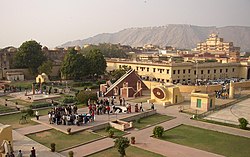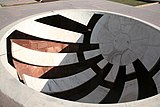Jantar Mantar, Jaipur: Difference between revisions
No edit summary |
|||
| Line 68: | Line 68: | ||
*[http://www.jantarmantar.org/Architecture_Science_web.pdf Architecture in the Service of Science] |
*[http://www.jantarmantar.org/Architecture_Science_web.pdf Architecture in the Service of Science] |
||
*[http://www.travelinput.com/jantar-mantar-the-jaipur-astronomical-instruments-collection/ Jantar Mantar Detailed information of each instrument with related pictures] |
*[http://www.travelinput.com/jantar-mantar-the-jaipur-astronomical-instruments-collection/ Jantar Mantar Detailed information of each instrument with related pictures] |
||
* [http://www.gounesco.com/train-travel-itinerary-world-heritage-sites-india/ Train travel to UNESCO world heritage sites in India] |
|||
{{World Heritage Sites in India}} |
{{World Heritage Sites in India}} |
||
Revision as of 03:50, 7 January 2014
This article needs additional citations for verification. (November 2012) |
| UNESCO World Heritage Site | |
|---|---|
 | |
| Criteria | Cultural: iii, iv |
| Reference | 1338 |
| Inscription | 2010 (34th Session) |
26°55′29″N 75°49′28″E / 26.92472°N 75.82444°E The Jantar Mantar is a collection of architectural astronomical instruments, built by Sawai Jai Singh who was a Rajput king served Emperor Aurangzeb and later Mughals. The title of (King) and Sawai was bestowed on him by Emperor Mohammad Shah. Jai Singh II of Amber built his new capital of Jaipur between 1727 and 1734. It is also located in Ujjain and Mathura.
It is modeled after the one that he had built at the Mughal capital of Delhi. He had constructed a total of five such facilities at different locations, including the ones at Delhi and Jaipur. The Jaipur observatory is the largest and best preserved of these. It has been inscribed on the World Heritage List as "an expression of the astronomical skills and cosmological concepts of the court of a scholarly prince at the end of the Mughal period".[1] Early restoration work was undertaken under the supervision of Major Arthur Garrett, a keen amateur astronomer, during his appointment as Assistant State Engineer for the Jaipur District.[2] The Jantar Mantar was made by Sawai Jai Singh as he was particularly interested in learning about the sky above his head.
Name
The name is derived from jantar[disambiguation needed] ("instrument"), and mantar ("formula", or in this context "calculation"). Therefore jantar mantar means literally 'calculation instrument'. This observatory has religious significance, since ancient Indian astronomers were also Jyotisa masters.

Description


The observatory consists of fourteen major geometric devices for measuring time, predicting eclipses, tracking stars' location as the earth orbits around the sun, ascertaining the declinations of planets, and determining the celestial altitudes and related ephemerides. Each is a fixed and 'focused' tool. The Samrat Yantra, the largest instrument, is 90 feet (27 m) high, its shadow carefully plotted to tell the time of day. Its face is angled at 27 degrees, the latitude of Jaipur. The Hindu chhatri (small cupola) on top is used as a platform for announcing eclipses and the arrival of monsoons.
Built from local stone and marble, each instrument carries an astronomical scale, generally marked on the marble inner lining. Bronze tablets, all extraordinarily accurate, were also employed. Thoroughly restored in 1901, the Jantar Mantar was declared a national monument in 1948.
An excursion through Jai Singh's Jantar is a unique experience of walking through solid geometry and encountering a collective astronomical system designed to probe the heavens.

The instruments are in most cases huge structures. The scale to which they have been built has been alleged to increase their accuracy. However, the penumbra of the sun can be as wide as 30 mm, making the 1mm increments of the Samrat Yantra sundial devoid of any practical significance. Additionally, the masons constructing the instruments had insufficient experience with construction of this scale, and subsidence of the foundations has subsequently misaligned them. The samrat yantra, for instance, which is a sundial, can be used to tell the time to an accuracy of about two seconds in Jaipur local time.[3] The Giant Sundial, known as the Samrat Yantra (The Supreme Instrument) is the world's largest sundial, standing 27 meters tall. Its shadow moves visibly at 1 mm per second, or roughly a hand's breadth (6 cm) every minute, which can be a profound experience.
To the day, the observatory is used by astronomers, i.e., to calculate the auspicious date for weddings. Students of astronomy and Vedic astrology (Jyotish) are required to take lessons at the observatory, and it can be said that the observatory is the single most representative work of Vedic thought that still survives, apart from the scriptures.
Many of the smaller instruments display remarkable innovation in architectural design and its relation to function, for instance the Ram Yantra. In addition, the five Jantar Mantars of northern India are a popular tourist attraction and significant monuments of the history of astronomy.

Filming location
It was used as a filming location for the 2006 film The Fall as a maze.
Storm Thorgerson photographed the sundial for the cover of Shpongle's DVD, Live at the Roundhouse 2008.[4]
See also
References
- ^ "The Jantar Mantar, Jaipur - UNESCO World Heritage Centre". Whc.unesco.org. 2010-07-31. Retrieved 2012-11-11.
- ^ Monthly Notices of the Royal Astronomical Society, Vol. 81, p.257
- ^ Barry Perlus. "Architecture in the Service of Science: The Astronomical Observatories of Jai Singh II" (PDF). Jantarmantar.org. Retrieved 2012-11-11.
- ^ "Twisted Music". Twisted Music. 2009-10-23. Retrieved 2012-11-11.
Further reading
- Sharma, Virendra Nath and aditya sharma (1995). Sawai Jai Singh and his astronomy. Motilal Banarsidass Publishers Pvt. Ltd. ISBN 81-208-1256-5.
External links
- Beautiful photos of Jantar Mantar
- Jantar Mantar Stone Observatory(Jaipur)
- Jantar Mantar (Jaipur)
- Website for Jantar Mantar in Jaipur - Biggest Stone Observatory in the World (Info)
- Architecture in the Service of Science
- Jantar Mantar Detailed information of each instrument with related pictures
- Train travel to UNESCO world heritage sites in India
